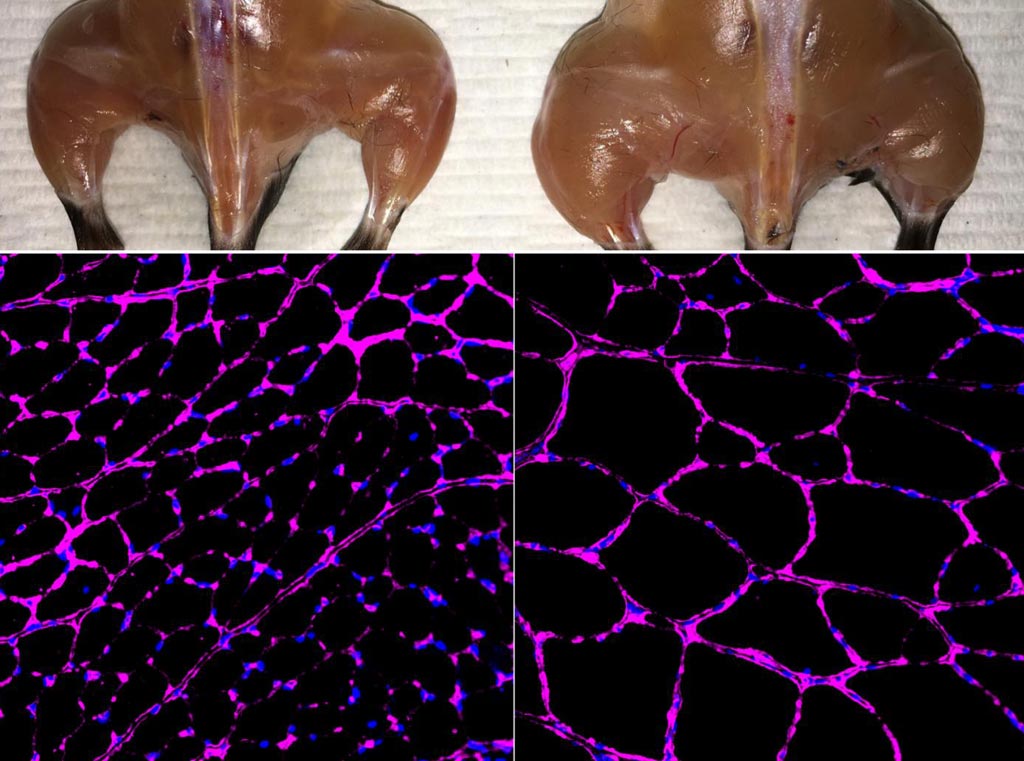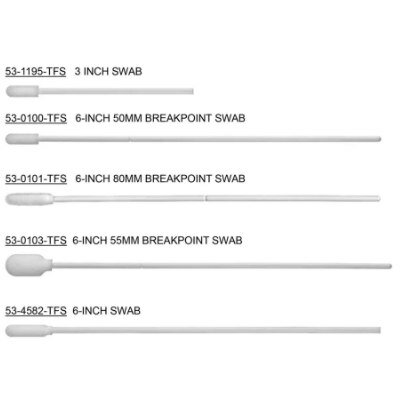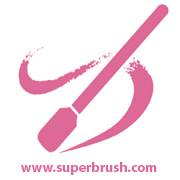Novel Gene Therapy Based on Modified Version of CRISPR/Cas9 Tool
|
By LabMedica International staff writers Posted on 21 Dec 2017 |

Image: An advanced in vivo Cas9-based epigenetic gene activation system enhances skeletal muscle mass (top) and fiber size growth (bottom) in a treated mouse (right) compared with an independent control (left). The fluorescent microscopy images at bottom show purple staining of the laminin glycoprotein in tibialis anterior muscle fibers (Photo courtesy of the Salk Institute for Biological Research).
A modified form of the CRISPR/Cas9 gene-editing tool does not cause "double-strand breaks" (DSBs) in the DNA, yet it retains the ability to target and activate specific sites in the genome.
CRISPR/Cas9 is regarded as the cutting edge of molecular biology technology. CRISPRs (clustered regularly interspaced short palindromic repeats) are segments of prokaryotic DNA containing short repetitions of base sequences. Each repetition is followed by short segments of "spacer DNA" from previous exposures to a bacterial virus or plasmid. CRISPRs are found in approximately 40% of sequenced bacteria genomes and 90% of sequenced archaea. CRISPRs are often associated with cas genes that code for proteins related to CRISPRs.
Since 2013, the CRISPR/Cas system has been used in research for gene editing (adding, disrupting, or changing the sequence of specific genes) and gene regulation. By delivering the Cas9 enzyme and appropriate guide RNAs (gRNAs) into a cell, the organism's genome can be cut at any desired location. The conventional CRISPR/Cas9 system is composed of two parts: the Cas9 enzyme, which cleaves the DNA molecule and specific RNA guides that shepherd the Cas9 protein to the target gene on a DNA strand.
In a paper published in the December 7, 2017, online edition of the journal Cell, investigators at the Salk Institute for Biological Research (La Jolla, CA, USA) used a modified version of CRISPR/Cas9. This version is based on a catalytically inactive form of Cas9 (dCas9), which can still target specific sites in the genome, but no longer induces DSBs that cut DNA. CRISPR/dCas9 associates with transcriptional activation domains, which are molecular switches that activate targeted genes.
Delivery of the CRISPR/dCas9 complex required development of a new methodology, as it was too large to fit into the commonly used adeno-associated virus (AAV) transport system. Therefore, the investigators separated the editing tool into its two primary components by generating a dual-AAV system based on co-injection of AAV-dCas9 with a separate AAV-gRNA.
The investigators used this technique to treat mouse models of diabetes, muscular dystrophy, and acute kidney disease. Results demonstrated that CRISPR/dCas9-mediated target gene activation could be achieved in vivo, leading to measurable phenotypes and amelioration of disease symptoms.
"Although many studies have demonstrated that CRISPR/Cas9 can be applied as a powerful tool for gene therapy, there are growing concerns regarding unwanted mutations generated by the double-strand breaks through this technology," said senior author Dr. Juan Carlos Izpisua Belmonte, a professor in the gene expression laboratory at the Salk Institute for Biological Research. "We were able to get around that concern."
Related Links:
Salk Institute for Biological Research
CRISPR/Cas9 is regarded as the cutting edge of molecular biology technology. CRISPRs (clustered regularly interspaced short palindromic repeats) are segments of prokaryotic DNA containing short repetitions of base sequences. Each repetition is followed by short segments of "spacer DNA" from previous exposures to a bacterial virus or plasmid. CRISPRs are found in approximately 40% of sequenced bacteria genomes and 90% of sequenced archaea. CRISPRs are often associated with cas genes that code for proteins related to CRISPRs.
Since 2013, the CRISPR/Cas system has been used in research for gene editing (adding, disrupting, or changing the sequence of specific genes) and gene regulation. By delivering the Cas9 enzyme and appropriate guide RNAs (gRNAs) into a cell, the organism's genome can be cut at any desired location. The conventional CRISPR/Cas9 system is composed of two parts: the Cas9 enzyme, which cleaves the DNA molecule and specific RNA guides that shepherd the Cas9 protein to the target gene on a DNA strand.
In a paper published in the December 7, 2017, online edition of the journal Cell, investigators at the Salk Institute for Biological Research (La Jolla, CA, USA) used a modified version of CRISPR/Cas9. This version is based on a catalytically inactive form of Cas9 (dCas9), which can still target specific sites in the genome, but no longer induces DSBs that cut DNA. CRISPR/dCas9 associates with transcriptional activation domains, which are molecular switches that activate targeted genes.
Delivery of the CRISPR/dCas9 complex required development of a new methodology, as it was too large to fit into the commonly used adeno-associated virus (AAV) transport system. Therefore, the investigators separated the editing tool into its two primary components by generating a dual-AAV system based on co-injection of AAV-dCas9 with a separate AAV-gRNA.
The investigators used this technique to treat mouse models of diabetes, muscular dystrophy, and acute kidney disease. Results demonstrated that CRISPR/dCas9-mediated target gene activation could be achieved in vivo, leading to measurable phenotypes and amelioration of disease symptoms.
"Although many studies have demonstrated that CRISPR/Cas9 can be applied as a powerful tool for gene therapy, there are growing concerns regarding unwanted mutations generated by the double-strand breaks through this technology," said senior author Dr. Juan Carlos Izpisua Belmonte, a professor in the gene expression laboratory at the Salk Institute for Biological Research. "We were able to get around that concern."
Related Links:
Salk Institute for Biological Research
Latest BioResearch News
- Genome Analysis Predicts Likelihood of Neurodisability in Oxygen-Deprived Newborns
- Gene Panel Predicts Disease Progession for Patients with B-cell Lymphoma
- New Method Simplifies Preparation of Tumor Genomic DNA Libraries
- New Tool Developed for Diagnosis of Chronic HBV Infection
- Panel of Genetic Loci Accurately Predicts Risk of Developing Gout
- Disrupted TGFB Signaling Linked to Increased Cancer-Related Bacteria
- Gene Fusion Protein Proposed as Prostate Cancer Biomarker
- NIV Test to Diagnose and Monitor Vascular Complications in Diabetes
- Semen Exosome MicroRNA Proves Biomarker for Prostate Cancer
- Genetic Loci Link Plasma Lipid Levels to CVD Risk
- Newly Identified Gene Network Aids in Early Diagnosis of Autism Spectrum Disorder
- Link Confirmed between Living in Poverty and Developing Diseases
- Genomic Study Identifies Kidney Disease Loci in Type I Diabetes Patients
- Liquid Biopsy More Effective for Analyzing Tumor Drug Resistance Mutations
- New Liquid Biopsy Assay Reveals Host-Pathogen Interactions
- Method Developed for Enriching Trophoblast Population in Samples
Channels
Clinical Chemistry
view channel
POC Breath Diagnostic System to Detect Pneumonia-Causing Pathogens
Pseudomonas aeruginosa is a major cause of hospital-acquired and ventilator-associated pneumonia, particularly in lung transplant recipients and patients with structural lung disease. Its ability to form... Read more
Online Tool Detects Drug Exposure Directly from Patient Samples
Doctors often rely on patient interviews and medical records to determine what medications a person has taken, but this information is frequently incomplete. People may forget drugs they used, take over-the-counter... Read moreMolecular Diagnostics
view channel
STI Molecular Test Delivers Rapid POC Results for Treatment Guidance
An affordable, rapid molecular diagnostic for sexually transmitted infections (STIs) has the potential to be globally relevant, particularly in resource-limited settings where rapid, point-of-care results... Read more
Blood Biomarker Improves Early Brain Injury Prognosis After Cardiac Arrest
After a cardiac arrest, many patients remain unconscious for days, leaving doctors and families facing uncertainty about whether meaningful recovery is possible. Current tools to assess brain damage, including... Read more
Biomarkers Could Identify Patients at High Risk of Severe AKI After Major Surgery
Acute kidney injury is one of the most common and dangerous complications after major surgery, particularly among patients in intensive care. Even mild impairment of kidney function can lead to long-term... Read more
CLIA Test Identifies Head and Neck Cancer Recurrence from Post-Surgical Lymphatic Fluid
While the lymphatic system’s critical role in metastasis has long been recognized, routine access to patient lymph has been elusive. Now, a non-invasive process can access lymph through the collection... Read moreHematology
view channel
MRD Tests Could Predict Survival in Leukemia Patients
Acute myeloid leukemia is an aggressive blood cancer that disrupts normal blood cell production and often relapses even after intensive treatment. Clinicians currently lack early, reliable markers to predict... Read more
Platelet Activity Blood Test in Middle Age Could Identify Early Alzheimer’s Risk
Early detection of Alzheimer’s disease remains one of the biggest unmet needs in neurology, particularly because the biological changes underlying the disorder begin decades before memory symptoms appear.... Read more
Microvesicles Measurement Could Detect Vascular Injury in Sickle Cell Disease Patients
Assessing disease severity in sickle cell disease (SCD) remains challenging, especially when trying to predict hemolysis, vascular injury, and risk of complications such as vaso-occlusive crises.... Read more
ADLM’s New Coagulation Testing Guidance to Improve Care for Patients on Blood Thinners
Direct oral anticoagulants (DOACs) are one of the most common types of blood thinners. Patients take them to prevent a host of complications that could arise from blood clotting, including stroke, deep... Read moreImmunology
view channel
Blood Test Could Identify Colon Cancer Patients to Benefit from NSAIDs
Colon cancer remains a major cause of cancer-related illness, with many patients facing relapse even after surgery and chemotherapy. Up to 40% of people with stage III disease experience recurrence, highlighting... Read moreBlood Test Could Detect Adverse Immunotherapy Effects
Immune checkpoint inhibitors have transformed cancer treatment, but they can also trigger serious immune-related adverse events that damage healthy organs and may become life-threatening if not detected early.... Read moreMicrobiology
view channel
Breakthroughs in Microbial Analysis to Enhance Disease Prediction
Microorganisms shape human health, ecosystems, and the planet’s climate, yet identifying them and understanding how they are related remains a major scientific challenge. Even with modern DNA sequencing,... Read more
Blood-Based Diagnostic Method Could Identify Pediatric LRTIs
Lower-respiratory tract infections (LRTIs) are a leading cause of illness and death worldwide, and pneumonia is the leading infectious cause of death in children under five, claiming the lives of over... Read morePathology
view channel
Rapid Low-Cost Tests Can Prevent Child Deaths from Contaminated Medicinal Syrups
Medicinal syrups contaminated with toxic chemicals have caused the deaths of hundreds of children worldwide, exposing a critical gap in how these products are tested before reaching patients.... Read more
Tumor Signals in Saliva and Blood Enable Non-Invasive Monitoring of Head and Neck Cancer
Head and neck cancers are among the most aggressive malignancies worldwide, with nearly 900,000 new cases diagnosed each year. Monitoring these cancers for recurrence or relapse typically relies on tissue... Read more
Common Health Issues Can Influence New Blood Tests for Alzheimer’s Disease
Blood-based tests for Alzheimer’s disease are transforming diagnosis by offering a simpler alternative to spinal taps and brain imaging. However, many people evaluated at memory clinics also live with... Read more
Blood Test Formula Identifies Chronic Liver Disease Patients with Higher Cancer Risk
Chronic liver disease affects millions worldwide and can progress silently to hepatocellular carcinoma (HCC), one of the deadliest cancers globally. While surveillance guidelines exist for patients with... Read moreTechnology
view channel
Machine Learning Models Diagnose ALS Earlier Through Blood Biomarkers
Amyotrophic lateral sclerosis (ALS) is a rapidly progressive neurodegenerative disease that is notoriously difficult to diagnose in its early stages. Early symptoms often overlap with other neurological... Read more
Artificial Intelligence Model Could Accelerate Rare Disease Diagnosis
Identifying which genetic variants actually cause disease remains one of the biggest challenges in genomic medicine. Each person carries tens of thousands of DNA changes, yet only a few meaningfully alter... Read moreIndustry
view channel
BD and Penn Institute Collaborate to Advance Immunotherapy through Flow Cytometry
BD (Becton, Dickinson and Company, Franklin Lakes, NJ, USA) has entered into a strategic collaboration with the Institute for Immunology and Immune Health (I3H, Philadelphia, PA, USA) at the University... Read more




















